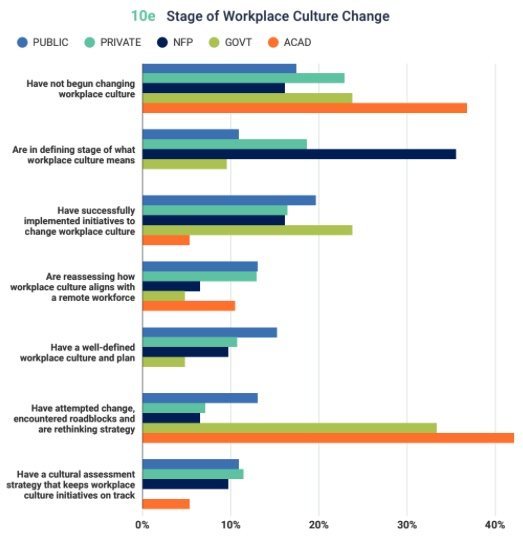The year 2024 is around the corner and the lingering effects of the COVID-19 pandemic continue to reveal trends, pressure points and areas for growth in the talent industry, shining a fresh spotlight on company ethics and employee well-being. According to data from the “2022 State of TM Analysis Report” by BetterWork Media Group, Talent Management’s parent organization, many companies lack well-defined workplace culture, and they’ve asked HR departments to fill in the gaps.
To assess the status of workplace culture change, BMG’s research arm polled 635 anonymous Talent Management subscribers from a variety of organizations. The data reveals several patterns and roadblocks in the progress toward workplace culture change. Here are the report’s key findings and takeaways.
Workplace culture gaining traction
According to BMG’s research, 60 percent of respondents indicated that their companies have tasked HR departments with workplace culture changes. This surge marks a four- to eight-point annual increase since 2019 and a significant influx of responsibility for HR professionals.
Because the pandemic prompted so many adjustments to the workforce paradigm in such a relatively short time, workplace culture change is a fairly new prerogative for many organizations. BMG’s research revealed that few organizations have had the resources or incubation time to realize clear, comprehensive culture change programs and various hiccups often stagnate early progres.
Researchers asked respondents to assume a standard definition of workplace culture as the shared values, beliefs, attitudes and assumptions within a workplace — positive workplace culture being one that “prioritizes the well-being of employees, offers support at all levels within the organization, and has policies in place that encourage respect, trust, empathy and support.”
Roadmap to workplace culture change
Though optimal methods for workplace culture change will vary according to organization-specific strengths, specs and limitations, the research suggests that favorable strategies concern the clear communication of company missions and values. That is, about 60 percent said workplace culture is built through including mission and value statements within the organization’s communications, and just below 60 percent said the same for onboarding (graph 10b).

Broadly, responses to the “how” of workplace culture change were split between personal tools (41 to 48 percent) and impersonal tools (50 to 60 percent). This relatively marginal division between personal and impersonal approaches suggests that the types of obstacles organizations encounter could have a greater bearing on progress changing workplace culture than the choice of building tools.
By a significant margin, participants indicated that management style was the largest barrier to workplace culture change. Budgetary constraints, management structure and lack of agility were fairly comparable, each hovering just above 30 percent (graph 10c). To this end, organizational leaders may be struggling to cultivate cohesive workplace culture while economic, cultural and technological changes are keeping the workforce in flux.
Though optimal methods for workplace culture change will vary according to organization-specific strengths, specs and limitations, the research suggests that favorable strategies concern the clear communication of company missions and values. That is, about 60 percent said workplace culture is built through including mission and value statements within the organization’s communications, and just below 60 percent said the same for onboarding (graph 10b).
By a significant margin, participants indicated that management style was the largest barrier to workplace culture change. Budgetary constraints, management structure and lack of agility were fairly comparable, each hovering just above 30 percent (graph 10c). To this end, organizational leaders may be struggling to cultivate cohesive workplace culture while economic, cultural and technological changes are keeping the workforce in flux.
Beneath the barriers
Focused efforts to form and strengthen workplace culture are relatively young; only 20 percent of organizations have established workplace culture, while 32 percent haven’t started the project. Just over one-third of respondents described their organizations in the beginning stage of establishing workplace culture, with another 14 percent saying their organizations were in flux. Without much precedent to rely on, organizations face an open-ended challenge when it comes to workplace culture change.

One notable consideration for the gradual pace of workplace culture change is the continuous introduction of new technology. With the recent boom in remote and hybrid work models, managers and employees of all levels must adapt to online interfaces and communication platforms. Just under 30 percent of respondents said tailoring workplace culture to a work environment including remote formats was their organization’s largest obstacle. Though BMG’s assessment of workplace culture maintains a general focus on status and patterns, the coming years will likely yield a more developed understanding of how and why certain factors delay workplace culture change.
With the bulk of internal communications having transitioned to digital interfaces, organizations are experiencing growing pains with systems such as file sharing (54 percent), instant messaging (51 percent) and discussion threads (41 percent). Ironically, technological platforms designed to facilitate and streamline communication might be doing the opposite when it comes to workplace culture.
Workplace culture change across organization types
Organizations of all types have been both slow to initiate workplace culture efforts and gradual in developing whatever processes they undertake. For those trudging through the beginning stages (either for the first time or after deciding to rework their approaches), identifying a clear definition and course of methods has been difficult. Between 15 and 20 percent of early-stage organizations are in the defining stage of workplace culture. A significant number of organizations decided to revisit and rework their initial definitions and action plans.

Researchers further examined workplace culture staging by organization type. So far, academia has encountered the greatest difficulty with the early stages of workplace culture change: 37 percent of organizations haven’t started and 42 percent attempted changes before returning to rethink their strategies. A solid 33 percent of government organizations have also returned to the drawing board, though the group saw early success with 24 percent having implemented initiatives.
A further look at variations in workplace culture change by organization type shows that privately held organizations were the most gradual and conservative in their approaches. Though 42 percent still haven’t crossed the starting line, less than 10 percent said their organizations were altering course after hitting roadblocks (graph 10e).
Having displayed the most consistency across stages of workplace culture change, publicly held organizations saw the highest number of responses indicating well-defined and established workplace culture plans (graph 10e). About 28 percent of public organizations haven’t started workplace culture change, 20 percent are in the beginning stage and 13 percent find themselves in flux.
Though limited, data on workplace culture tells the story of an organizational imperative that’s as young as it is symbolic of a workforce evolving to attract, retain and satisfy talent. While many organizations have been slow to start, the high concentration of organizations around the beginning stages suggests that workplace culture change could see significant growth in the coming years. And if the sizable population in redefining stages gives any indication, organizational leaders and HR professionals are dedicated to getting it right.











